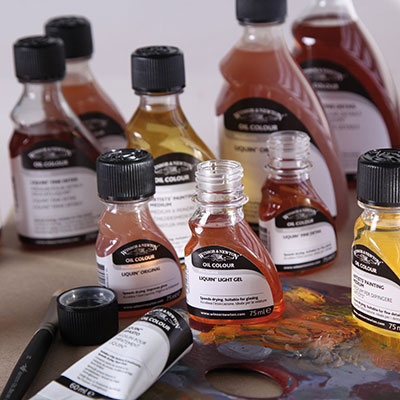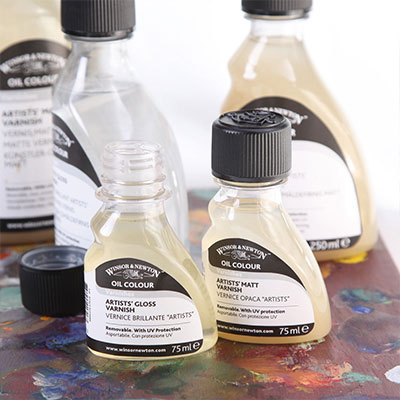£5 OFF Orders £55 | Use Code EW255
Oil Mediums
Artists' colours are the basic ingredients for the painter. However, the range of oils, mediums, varnishes, solvents and primers are additional ingredients from which an infinite variety of adjustments can be made to the colour, all to suit the individual creative vision of the artist.
Solvents
Solvents are used to dilute colour, as well as for cleaning brushes and palettes after a painting session. Solvents made for artists are intended to be fully volatile, meaning that upon evaporation from the paint mixture, they leave no residual matter behind.
Hardware/DIY grade solvents, though lower in cost, are not refined to the degree required for artists, and will often leave a tacky painting surface where used, and a paint film that won't fully dry. We offer a range of solvents to suit your different needs.
Aritsts' White Spirit Distilled Turpentine Sansodor (Low Odour Solvent) Artists' Picture Cleaner Unvarnished paintings may also be treated with Artists' Picture Cleaner but great care is necessary and the process should be stopped immediately if any colour seems to be coming off the painting. Artists' Picture Cleaner can effect an unbelievable improvement on paintings both simply and inexpensively but if you are in any doubt about the condition of the original painting or if the varnish is cracked, let the necessary work be done by an expert. |
Drying Oils
Drying and semi-drying oils are the vegetable oils used to make oil colour, namely linseed, poppy and safflower.
The different methods of processing oils produces products with different drying rates, consistencies and colour.
Drying oils are used to modify the consistency and drying time of colour in much the same way as prepared mediums.
There are a range of drying oils to suit your different needs:
Cold-Pressed Linseed Oil
A slightly yellow oil, which is extracted without the use of heat. This can be added to colour to reduce the consistency, improve flow, and increase gloss and transparency whilst reducing brush marks. Thin with Turpentine or Artist’s White Spirit.
This oil dries slightly quicker than refined linseed oil and may have better flow with some colours.
Thickened Linseed Oil
A pale refined oil of syrupy consistency. This speeds the drying time, improves flow and gloss and increases the durability of the film.
This oil behaves like Linseed Stand Oil but is dries quicker and darker.
Drying Linseed Oil
This is an oil of darker colour than Refined Linseed Oil, which promotes the fastest drying rate of all the oils whilst increasing gloss.
Refined Linseed Oil
The most popular oil offers many of the same qualities as Cold Pressed Linseed Oil, but is slower drying. It is an alkali-refined oil of pale colour that reduces oil colour consistency and increases gloss and transparency.
Linseed Stand Oil
A pale viscous oil that can be mixed with Turpentine or White (Mineral) Spirit to improve the flow and levelling of oil colour. Retards drying but imparts a tough, elastic finish. Use in conjunction with Turpentine or Artists’ White Spirit to improve colour flow. It is well suited for glazing and for fine detail and is resistant to yellowing while increasing the durability of the film. It slows drying and is the best oil to choose as an additive medium.
Drying Poppy Oil
A drying oil used to increase the drying rate. Made from poppy seeds, it is the palest of the oils and is resistant to yellowing which makes it well suited for whites and pale colours.
Mediums
Mediums are additives which alter or enhance the characteristics of the colour. They are used to change the rate of drying, increase gloss, improve flow, provide texture etc. Mediums are based on the binders used in milling the colours: linseed oil, alkyd resin and modified oils for water mixable oils.
Traditional oil based mediums are made from a combination of oil and solvents, while the alkyd based mediums combine synthetic alkyd resins and solvents. Because alkyd resin functions in much the same way as linseed oil, alkyd mediums may be added to conventional oils. Alkyd resin mediums offer dramatic advantages by accelerating the speed of drying, as well as adding a unique, natural translucency. We offer a range of mediums to suit your different needs.
All mediums should be used in moderation, they are intended only as an additive to the colour. In addition, you should avoid adding multiple mediums to the colour. The most stable film is likely to contain a single medium.
Artists' Painting Medium Liquin Original Liquin Impasto Medium When dry, it forms a flexible, tough film that can be varnished in the normal way. Liquin Impasto and Liquin Oleopasto are the only mediums that safely thicken oil colour. For heavier brush work or palette knife Liquin Fine Detail Medium Liquin Fine Detail is the modern alternative to the traditional copal mediums that were based on natural resins and offered fast drying properties to the artist. It will approximately half the drying time of oil colour, dependant on the proportions added. Therefore, depending on the climate, colours used, and film weight, the layer will be touch dry in anything between 1-5 days. Liquin Light Gel Medium This product offers all the handling properties traditionally seen with the historic Meglip mediums but without the tendencies to crack and yellow which are normally associated with mastic mediums. Choosing Liquin Light Gel is like selecting non drip gloss paint for decorating in favour of liquid gloss (Liquin Fine Detail). It provides looser handling. Liquin Oleopasto Medium This stiff, translucent gel is specifically for impasto and texture work. It dries to a crack-resistant and virtually non-yellowing film, it retains knife and brush strokes and will not level out. |
Varnishes
Varnishes are final coatings which protect finished pictures from the build up of dirt and grease. Oil paintings must be thoroughly dry (at least 6 -12 months) before varnishing. We offer a range of each of these varnishes to suit your different needs.
For fine art usage picture varnishes should be removable so that paintings can be cleaned in the future. Our varnishes are labelled ‘gloss' or ‘matt', it should be noted that different resins used in the varnishes impart varying degrees of gloss.
Japan Gold Size Artists' Gloss Varnish Artists' Matt Varnish Winsor & Newton Artists Satin Varnish Artists' Retouching Varnish Dammar Varnish |
See our range of Oil Mediums













